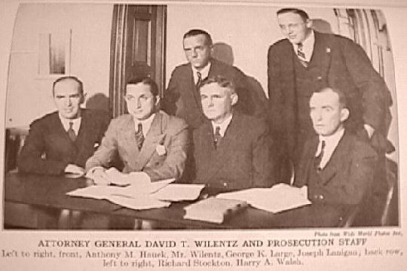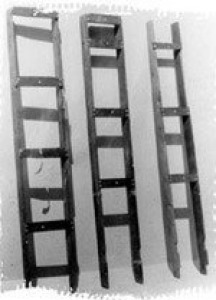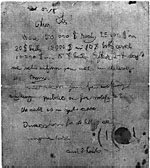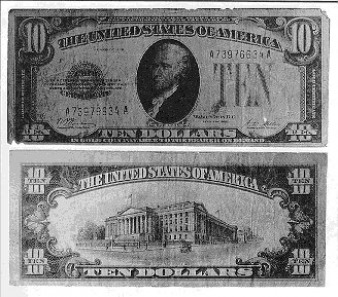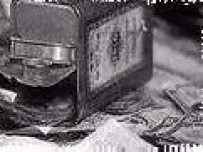The Case Against Bruno Hauptmann: Key Prosecution Evidence
The Hauptmann trial generated great controversy. Many people believed at the time--and some people continue to believe--that Hauptmann was innocent. Those maintaining Hauptmann's innocence emphasize that the prosecution's case was largely circumstantial. No one saw Bruno Hauptmann climb into Lindbergh's second-story window. No one saw him with the baby. Moreover, some of the evidence that people have come to expect at a criminal trial--crime scene fingerprints, a murder weapon--was never produced. Advocates of Hauptmann's innocence also point to the failure of the prosecutors to provide the defense with exculpatory evidence, initial FBI reports suggesting that the kidnaping required two persons, and police screw-ups (such as the failure of police to measure footprints found near the Lindbergh home). The suicide of Violet Sharpe, Lindbergh's maid, has been taken by some as evidence of her participation in an inside conspiracy. Finally, some people have been impressed by the fact that Hauptmann continued to assert his own innocence all the way to the electric chair. Nonetheless, the prosecution's case against Hauptmann was a strong one. Some of the key prosecution evidence is described below.
Evidence Relating to the Kidnapping
1. The key evidence tying Hauptmann to the actual kidnapping was a section of attic floor board taken from Hauptmann's Bronx apartment that precisely matched the grain of wood used for "rail 16" of the ladder found left at the kidnap scene. Moreover, rail 16 had four rare square nail holes that matched the nails used in Hauptmann's attic. Several jurors said after the trial that wood evidence was the most significant in proving Hauptmann's guilt.
2. Hauptmann had a criminal record in Germany. One conviction involved a second-story job using a ladder.
3. Millard Whited, a logger living a mile from the Lindbergh house, said that he saw Hauptmann prowling around the Lindbergh estate on two occasions in the days before the kidnapping.
1. The key evidence tying Hauptmann to the actual kidnapping was a section of attic floor board taken from Hauptmann's Bronx apartment that precisely matched the grain of wood used for "rail 16" of the ladder found left at the kidnap scene. Moreover, rail 16 had four rare square nail holes that matched the nails used in Hauptmann's attic. Several jurors said after the trial that wood evidence was the most significant in proving Hauptmann's guilt.
2. Hauptmann had a criminal record in Germany. One conviction involved a second-story job using a ladder.
3. Millard Whited, a logger living a mile from the Lindbergh house, said that he saw Hauptmann prowling around the Lindbergh estate on two occasions in the days before the kidnapping.
Evidence Relating to Ransom Demands
4. Hauptmann's handwriting had many points of similarity with the ransom notes. For example, both Hauptmann's handwriting and that found on the ransom notes had backward "N"s, unclosed "o"s, the same shaped "t"s, and the same curls to the "y"s.
5. Hauptmann misspelled many of the same words that were misspelled in the ransom notes. For example, Hauptmann and the author of the ransom notes both misspelled "where" as "were," "our" as "ouer," "later" as "latter," and "boat" as "boad."
4. Hauptmann's handwriting had many points of similarity with the ransom notes. For example, both Hauptmann's handwriting and that found on the ransom notes had backward "N"s, unclosed "o"s, the same shaped "t"s, and the same curls to the "y"s.
5. Hauptmann misspelled many of the same words that were misspelled in the ransom notes. For example, Hauptmann and the author of the ransom notes both misspelled "where" as "were," "our" as "ouer," "later" as "latter," and "boat" as "boad."
6. Dr. John Condon, the man who delivered the ransom money to a man named "John" in a dark cemetery testified that "John" resembled Bruno Hauptmann.
7. Charles Lindbergh testified that the voice of "John" that he heard in the cemetery sounded like the voice of Hauptmann.
8. A taxi driver testified that the man who gave him a note to deliver to Dr. Condon was Hauptmann.
9. Hauptmann quit his job within days after the ransom money was paid.
10. Dr. Condon's phone number was found written on a closet wall in Hauptmann's kitchen.
11. A gas station attendant and a movie theater cashier identified Hauptmann as having passed marked $10 gold certificates.
7. Charles Lindbergh testified that the voice of "John" that he heard in the cemetery sounded like the voice of Hauptmann.
8. A taxi driver testified that the man who gave him a note to deliver to Dr. Condon was Hauptmann.
9. Hauptmann quit his job within days after the ransom money was paid.
10. Dr. Condon's phone number was found written on a closet wall in Hauptmann's kitchen.
11. A gas station attendant and a movie theater cashier identified Hauptmann as having passed marked $10 gold certificates.
12. $14,000 in ransom money was found in a tin can in Hauptmann's garage. The ransom money was concealed by framing lumber and shellac.
The Evidence Against Hauptmann
Hauptmann was convicted with a variety of circumstantial, eyewitness and forensic evidence. The case against him seemed so convincing, that most of the press declared him guilty before the trial had even begun. Here’s an outline of the main areas of that evidence.
Handwriting Evidence
Comparing the ransom notes to samples of Hauptmann’s handwriting revealed similarities in grammar, spelling and penmanship. Several handwriting experts testified against Hauptmann. Despite defense attorney Edward Reilly’s promise to produce just as many experts to deny the writing was Hauptmann’s, the defense produced only one expert. His testimony was less than convincing.
Eyewitness Testimony
While no one witnessed the crime, or saw him with the Lindbergh child, Hauptmann was identified by several witnesses. Some said they had seen him in his car near the Lindbergh estate on the day of the kidnapping. Others were cashiers who said he had passed ransom bills. One was a cab driver who said he had delivered a note for Hauptmann to ransom go-between Dr. John Condon. A New York fashion model said she saw Hauptmann following Condon during ransom negotiations. Unwilling to identify Hauptmann after his arrest, during the trial Condon said Hauptmann was the man to whom he gave the ransom money.
The Ladder
The ladder used to reach the nursery window on the second story at the Lindbergh estate was left behind at the scene. It was a homemade device, in three sections, designed for ease of transport in a car. Experts traced the ladder’s wood through marks left by a faulty sawmill blade. One load of the wood had been shipped to a Queens, NY lumberyard near Hauptmann’s home. A side rail on the ladder showed nail holes that suggested it had been used before. Investigators determined that the wood matched a board in Hauptmann’s attic. During the trial, defense attorneys insisted that “there’s no such thing as a wood expert!” They said that the ladder had been tampered with by police.
The Gold Notes
The serial numbers of the ransom bills were recorded and a list distributed to banks across the nation. The ransom was paid in gold notes, which were slated to be removed from circulation in 1933. This made them very noticeable. Investigators followed the gold note trail for two years. Most of the bills were passed in or near New York City. The break in the case came when a suspicious gas station attendant wrote the license plate of his customer in the margin of his gold note bill. The car was registered to Bruno Richard Hauptmann, who was arrested the next day. At the time of his arrest, he was carrying a $20 ransom bill. Another $14,000 in ransom money was found hidden in his garage. At his trial, a detailed accounting of Hauptmann’s finances indicated a sudden rise in wealth just after the ransom had been paid.
Click here for further information:
Hunterdon County Democrat: Lindbergh Trial
Hauptmann was convicted with a variety of circumstantial, eyewitness and forensic evidence. The case against him seemed so convincing, that most of the press declared him guilty before the trial had even begun. Here’s an outline of the main areas of that evidence.
Handwriting Evidence
Comparing the ransom notes to samples of Hauptmann’s handwriting revealed similarities in grammar, spelling and penmanship. Several handwriting experts testified against Hauptmann. Despite defense attorney Edward Reilly’s promise to produce just as many experts to deny the writing was Hauptmann’s, the defense produced only one expert. His testimony was less than convincing.
Eyewitness Testimony
While no one witnessed the crime, or saw him with the Lindbergh child, Hauptmann was identified by several witnesses. Some said they had seen him in his car near the Lindbergh estate on the day of the kidnapping. Others were cashiers who said he had passed ransom bills. One was a cab driver who said he had delivered a note for Hauptmann to ransom go-between Dr. John Condon. A New York fashion model said she saw Hauptmann following Condon during ransom negotiations. Unwilling to identify Hauptmann after his arrest, during the trial Condon said Hauptmann was the man to whom he gave the ransom money.
The Ladder
The ladder used to reach the nursery window on the second story at the Lindbergh estate was left behind at the scene. It was a homemade device, in three sections, designed for ease of transport in a car. Experts traced the ladder’s wood through marks left by a faulty sawmill blade. One load of the wood had been shipped to a Queens, NY lumberyard near Hauptmann’s home. A side rail on the ladder showed nail holes that suggested it had been used before. Investigators determined that the wood matched a board in Hauptmann’s attic. During the trial, defense attorneys insisted that “there’s no such thing as a wood expert!” They said that the ladder had been tampered with by police.
The Gold Notes
The serial numbers of the ransom bills were recorded and a list distributed to banks across the nation. The ransom was paid in gold notes, which were slated to be removed from circulation in 1933. This made them very noticeable. Investigators followed the gold note trail for two years. Most of the bills were passed in or near New York City. The break in the case came when a suspicious gas station attendant wrote the license plate of his customer in the margin of his gold note bill. The car was registered to Bruno Richard Hauptmann, who was arrested the next day. At the time of his arrest, he was carrying a $20 ransom bill. Another $14,000 in ransom money was found hidden in his garage. At his trial, a detailed accounting of Hauptmann’s finances indicated a sudden rise in wealth just after the ransom had been paid.
Click here for further information:
Hunterdon County Democrat: Lindbergh Trial
